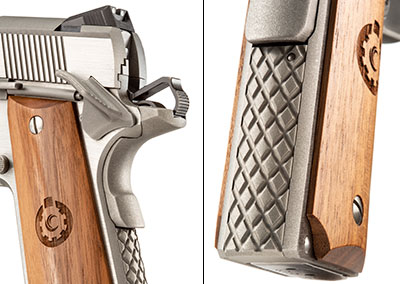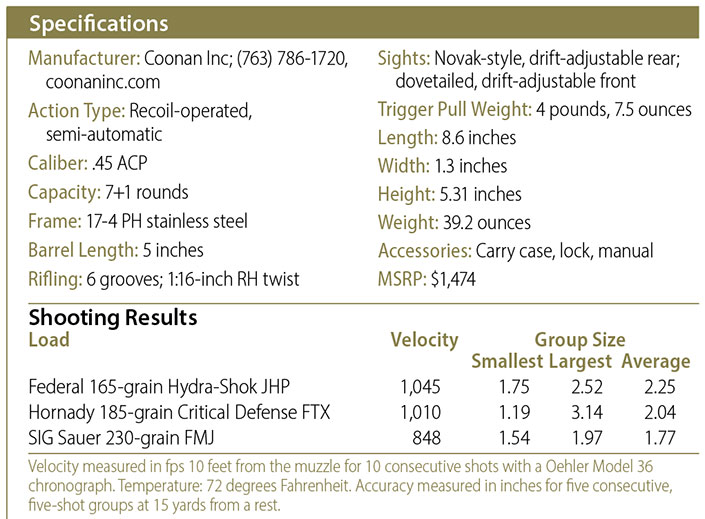By Bob Boyd, Shooting Illustrated
Given the vast number of 1911 manufacturers producing clones of John Browning’s masterpiece, it’s easy to understand how fans may find themselves in sensory overload amidst the steady influx of new arrivals in an already crowded market.
Nowhere is that better exemplified than with the name Coonan—a brand well-known to the firearm industry in general and 1911 fans in particular. Founder Dan Coonan, while studying engineering in college, designed and manufactured a semi-automatic handgun resulting from an ongoing argument with his roommate over which was better: a revolver chambered in .357 Mag. or a 1911 chambered in .45 ACP. Coonan sided with the semi-automatic, but conceded the significant ballistic capabilities of the magnum cartridge.
While the Coonan MOT-45 may resemble its magnum sibling at first, one need only handle the pistol to instantly detect a noticeable difference—a much narrower grip circumference, which allows the pistol to be a .45 ACP version of the iconic-looking semi-automatic.

Given the time and research Coonan spent developing his pistol around the .357 Mag. and subsequent to the shorter frame and slide of Coonan Compact pistols, arrival of the MOT-45—and especially its chambering—seems somewhat counter-evolutionary; at least it did at first. But, the more I thought about it, a full-size Coonan in .45 ACP made perfect sense. After designing his namesake pistol to successfully operate under the higher pressures of the .357 Mag., the addition of another handgun chambered in a shorter cartridge to the company’s lineup should have proven much less challenging. The result is a pistol designed to compete in the crowded market of 1911 clones chambered in .45 ACP. Do not, however, associate anything wearing a Coonan rollmark as just another 1911. Closer inspection of the MOT-45 reveals several features that are unique and useful. Such distinctions do more than to set it apart from most commercial offerings. To the contrary, they serve as a testament to what the company founder commonly refers to as “the Coonan difference.”
Perhaps the most obvious of unique characteristics is the Coonan’s pivoting trigger that boasts a perfectly proportioned shoe, with a slight scoop that has just enough width to accommodate the pad of the shooter’s trigger finger. Though it’s easy to dismiss this as an aesthetic frill, the increased bearing surface provides optimal leverage for greater trigger control and a light, crisp let-off.
In another departure from a conventional 1911, the Coonan MOT-45 features an external extractor tensioned by a coil spring, rather than an internal extractor that relies on one of various leaf-spring designs.

However, not all of the changes are exterior. Coonan pistols sport a different barrel configuration, which relies on a Browning-inspired camming design, as opposed to a 1911 where the vertical movement is controlled by a toggling link—a feature some of the most die-hard 1911 mavens consider to be the pistol’s major flaw. Such a linkless design requires less barrel movement for enhanced reliability and could possibly provide greater accuracy potential.
Though the manufacturer doesn’t count it as part of the “Coonan difference,” the addition of a full-length dustcover provides a sense of continuity between the pistol’s slide and frame by allowing the pistol’s lines to flow together, while the added mass beneath the barrel should aid in mitigating felt recoil—a nice touch that is cosmetic as much as it is practical. Elements of practicality are found throughout the MOT-45, such as a flat mainspring housing and beavertail grip safety. The latter is built up to promote positive sear disengagement by placing the hand closer to the pistol’s bore axis, lessening muzzle flip while promoting an optimum firing grip. The single-sided thumb safety also aids in this regard. Its long and narrow paddle provides a perfect ledge for the shooter’s thumb during firing. While Coonan’s thumb safety is more than sufficient for most shooters, I’d consider an ambidextrous model a more-practical alternative, not just from the standpoint of a southpaw shooter, but because an ambidextrous safety provides the means for practicing both strong- and weak-hand shooting.
Once I got to the range, I was pleased with the ergonomics of the MOT-45, but only somewhat. Smooth walnut stocks proved to be a welcome departure from the current flood of pistols with G10 slabs that are so coarse they could double as a cheese grater. However, extending the same surfaces to the frontstrap and mainspring housing allowed the pistol to slide too easily in hand under recoil. Mild serrations fore and aft would offer much-needed purchase without significantly adding to the price of the pistol.
Similarly, while the pistol’s extended thumb safety and slide stop are equally uncommon features, I rapidly became a fan as they permitted easy access to the fire controls without having to cant the pistol or slingshot the slide to chamber a round. Though such a practice may not be in vogue, I would much rather actuate the slide stop because it allows keeping both hands on the pistol without compromising one’s defensive readiness. With all three loads tested, the pistol performed flawlessly, though, to my surprise, it displayed no penchant for any particular type of bullet. Group sizes ranged from 1.19 inches to 3.14 inches at 15 yards. Dimensions became predictably tighter, ragged-hole clusters within the distances at which life-threatening encounters typically occur.
Far from an ordinary 1911, the Coonan MOT-45 offers the dependability of a classic pistol along with the modern touches fans have come to expect.

Thanks to Shooting Illustrated for this post. Click here to visit ShootingIllustrated.com.
Better yet: Click here to subscribe to SI’s free newsletter.



